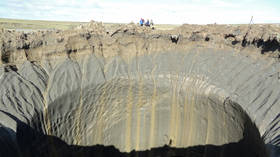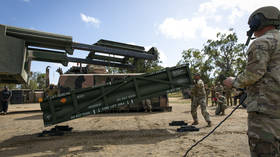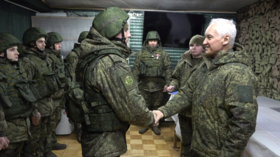The plot thickens! Another GIANT crater appears in Siberia, making it vast Russian territory’s 17th mystery pit (PHOTOS,VIDEOS)

A suspected underground methane explosion has created a 50-meter-deep (164ft) crater on the Yamal Peninsula in northwest Siberia. The vast sinkhole was spotted by chance as a news crew flew past.
The crater, believed to be the largest discovered in the region so far, is the 17th such sink hole in the area. They are believed to be caused by melting permafrost combined with major build-ups of expanding methane gas thanks to high summer temperatures.
The major explosion sent soil and ice flying into the air, causing it to rain down upon the area, with scientists investigating ‘Number 17’ discovering debris hundreds of feet away from the crater.
Giant new 50-metre deep 'crater' opens up in Arctic tundra. Blocks of soil and ice thrown hundreds of metres from epicentre of the funnel at the Yamal peninsula https://t.co/2fTA8GZRS4#YamalFunnels2020pic.twitter.com/t5CJRVwuRS
— The Siberian Times (@siberian_times) August 29, 2020
The phenomenon was first reported in 2014 and has perplexed scientists ever since, as these ‘funnels’ appear to be expanding.
The leading theory, that they are created by a buildup of methane gas which erupts beneath a pingo – an ice-covered mound found in the Arctic permafrost landscape, otherwise known as a hydrolaccolith – goes some way towards explaining the odd goings-on.
However, ‘Number 17’ exploded outwards rather than collapsing inwards like its predecessors, necessitating more in-depth research.
“This is a subject for scientific publications,” Vasily Bogoyavlensky, a scientist with the Russian Oil and Gas Research Institute, told Vesti Yamal TV. “We have to analyze all this, and build three-dimensional models.”
Also on rt.com The Thing: Melting Siberian permafrost reveals terrifying creatures (PHOTOS)The Yamal Peninsula is the home of Russia’s largest natural gas field, a key source of fuel supply used to heat Europe during the winter. Some 7,000 gas pockets were previously discovered beneath the area.
The phenomenon happens relatively quickly in some of the most remote regions of the world, making them very difficult to study, let alone predict.
“The frost heaving that precedes a crater usually happens quite quickly, over one to two years, and this sudden growth is hard to observe, so almost all craters were discovered after everything had already happened,” researcher Evgeny Chuvilin said previously.
He added that the craters quickly turn into lakes over a matter of months, making new ones difficult to distinguish from the thermokarst lakes which already dot the landscape, further frustrating research efforts.
Also on rt.com They’re back! Worms unfrozen after 42,000 years are alive and eatingThink your friends would be interested? Share this story!














